<--- back to [i]sland [d]rift page...
Discarded car-centric vision of Amsterdam in the 1960s
In the 1960s, it seemed clear that the future was the car. Amsterdam had its own plans about how to make the city more car-friendly. Some of these plans failed, others only partially. Discover how radically different Amsterdam might have been had these plans succeeded.
UTRECHT - Removing a motorway to bring back the original waterway
Utrecht changed its former city moat into a motorway in the early 1970s. The process has now been reversed. In December 2015 the new canal replacing the motorway was officially opened. The water - dating back from the 12th century - has returned.
walking route:
SCHINKELEILANDEN PARK
24.11.2021
ROUTE:
Rietveld
Olympic Stadium
House of Detendion II
Haavenstraat
Schinkeleilanden Park Rietveld
Park Schinkeleilanden is located west of the Olympic Stadium. The park is easily accessible from the Olympic Quarter area via the Jan Wils Bridge (Jan Wils was the designer of the Olympic Stadium).
CLICK HERE TO FIND MORE ABOUT
SCHINKELEILANDEN PARK
Kanal returning to Utrecht in 2015 - layered on top of highway plans of 1965
The film is based on the true story of engineer Giorgio Rosa and the Republic of Rose Island.
https://en.wikipedia.org/wiki/Rose_Island_(film)
https://wepresent.wetransfer.com/story/asafo-flags/
walking route:
IJBURG - ZEEBURG
12.01.2022
ROUTE:
Steigereiland metro
IJburg
Hein de Haanbrug
Diemerzeedijk
Amesterdamsebrug
Herberg Zeeburg
Waterkeringpad
Nesciobrug
Hein de Haanbrug
IJburg
Steigereiland metro
The Herberg Zeeburg, built in 1675, is located in the Indische Buurt and is built near the former stronghold of Zeeburg, at the time situated on the Zuiderzee. The inn (Herberg) was a place to stay for travellers and merchants and a good mooring place on the Zuiderzee. Besides fish, a lot of cattle was transported here (pigs, cows and horses from Friesland, Groningen, Hannover and Denmark) to the cattle market in Amsterdam. The cattle was placed on the lands along the Zeeburgerdijk to be fed up and fattened, after which it was transported over de Zeeburgerdijk to the cattle market on the Amstel, near the Utrechtse Poort, for trade. In 1877 the cattle market moved to a new location on the Zeeburgerdijk, closer to the inn. Rembrandt visited the inn multiple times and made some drawings here. The inn had stables, sheds and a haystack. Crowds could gamble on horses during the horse races which were held on the dyke. Following the annexation of 1896 of Diemen, the inn came to be in the municipality of Amsterdam, ahead of the building of the Indische Buurt. The building remained in use as an inn until 1915, after which it became part of the municipal quarantine station, or Quarantine Inrichting Zeeburg. The inn was used as an office and a manager’s villa and several barracks were built here. Later refugees were housed here. After 1945 the complex functioned as Noodziekenhuis Zeeburg (emergency hospital), until the newly built Slotervaart Hospital opened in 1975. The barracks were demolished and the inn was transformed into an apartment complex. It is the oldest nationally listed building in the Indische Buurt
In 1914 several wooden buildings were built on Zeeburgerdijk for the Municipal Quarantine Station, later called Quarantine Inrichting Zeeburg. The complex consisted of a villa , ten barracks and an office. The management was based in the villa and the office was located in Herberg Zeeburg . In the 1930s, the complex became vacant and was then used to accommodate refugees.
After 1945, the Zeeburg Emergency Hospital was established in the barracks, awaiting new construction. This came about in 1975 with the construction of the new Slotervaart Hospital. The emergency hospital also included a department where patients could be quarantined . There was also a special children's ward for TB patients. At least in the years 1949-1951. The emergency hospital was remote at the time and only during visiting hours on Wednesdays, Fridays and Sundays there was a shuttle service with a small van connecting to bus line 11, later bus line 22 .
The barracks were demolished in 1998. There are now terraced houses next to a sports hall and the Flevopark tram terminus. The inn still stands.
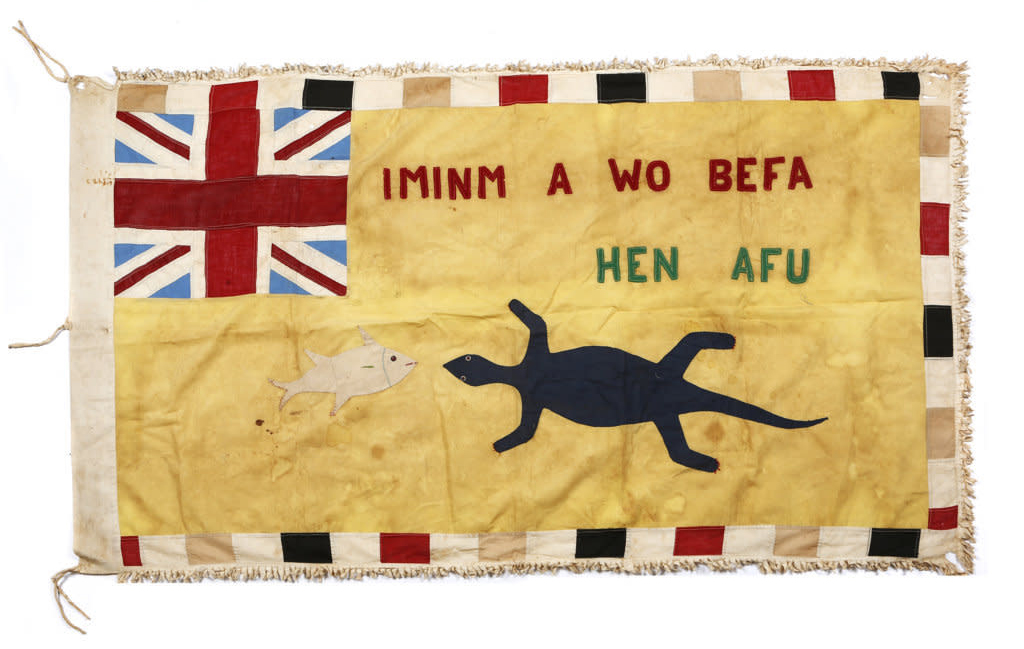
Rose Island is a 2020
Italian comedy-drama film directed by Sydney Sibilia
session iii
[I]sland [D]rift is looking into islands as physical entities and as symbolic manifestations of our fluid relations with each other and the world. How are we to understand islands as seemingly autonomous ‘bodies’ enclaved by bodies of water? How are we to relate with the concept as bodies of water ourselves?
Anchoring on those concepts & questions, the group is to tap into politics of modern travel juxtaposed against waves of migration, both interlaced with notions of hospitality, fortification, isolation and escapism.
UNCUT PROPOSAL
(first draft)
session ii
utopia - as a non-place
imaginative geography for an utopian future (philosopher’s islands)
a space of 'becoming'
a body that constantly morphs
a process of constant reconfiguration of identity
welcoming - hospitable topos
emerged land (from the ocean) – visible body/appearing
submerged sinking land (tides) - invisible body/disappearing
a piece of land merging with the mainland (dried waters)
a virtual space
a server interconnected with other servers
a social media platform
an ecosystem
a complex constellation of fragmented identities
enclosed ecosystem of beliefs (scientific/political/religious etc.)
a bubble
the rational, the dialectic (according to Plato philosophy)
a colonial body
a space of extractivism and explotation of its identity and resources
economically interconnected entity with the main land
tax havens
real topology of destopian present and future (Nauru island, Guatanamo)
an artificial body (Dubai islands)
a fortified place
a geography with its coastlines as borders
a place of captivity
a prison (Alcatraz)
a refugee camp
a quarantine space (lazarettos)
a waste-dump
an invisible body
a body in extinction
isolated and hermitic entity
a seemingly autonomous state
land caught in dispute over nation borders (Imia island)
a metaphor for time:
time-zone (past – present – future)
ocean as...
island as...
We are taking reference from the maritime flag system – shapes/colors/meaning of flags and we create a series of flags as an extension to that system – bringing more colours and shapes in – naming our flags based on the alphabet and of course compose our own coded messages.
These messages refer to not only boat to boat communication but are open to signalling from various positions – from the sea to the coast – from the coast to the sea – from an island to an island etc.
They are poetic messages that are a bit more open ended that the ones that already exist. They can be also commentaries or statements we wish to signal out to the world.
Thinking of presenting them as an archive/display of flags which also speak to each other – meaning that we can have multiple combinations of one flag next to another.
Inviting the audience to choose the flags/messages they like and hang them on a rope – similar to how it is done in a boat.
(Idea to us the masts /flag-pols that are outside the Stedelijk for that, but thiking also other ways to display them)
Considering taking our new symbols made (inspired by the existing flags): new shapes, new colours etc and create a visual vocabulary where audience can use to create their own flags and messages.
They can play with the visual symbols and combine them and think of a name and a message.
UNCUT suggested that this might be nice to do as a workshop where we introduce the audience to the maritime flag system and ours, have them engage with this code systems and send out their signals.
Through a series of collective walking encounters and by drawing further inspiration from nautical flags as a code of communication between ships and the coastlines, the group wishes to develop their own visual language of signalling towards each other and space.
With regards to form, flags have so far become a common place for us, meaning that we are
predominately interested in producing textiles (as signals) to be presented as an installation at Stedelijk and potentially be activated in space through performative gestures (to be confirmed).
UNCUT PROPOSAL
(update 20.01.22)
island as...
collective mind-map
ocean as...
collective mind-map
* both a a welcoming and hostile entity
* a reticence / reserved topos; the vast blue sea, full of secrets and stories (personal & universal).The ocean's upthrust is working selectively, allowing some to surface and others to be held in the deep - never risen or heard.
* a graveyard
nautical flags
Flaghoist signalling
Flaghoist signalling is one or more flags (or pennants) simultaneously flying from a fixed halyard, and generally any method of signaling by such means.
Each of the flags has a distinct shape and color combination.
Each flag or combination of flags has a preassigned meaning or "code". The International Code of Signals (ICS) defines a standard set of flags and associated alphabet suitable for international use, as well as a set of standard codes.
Maritime flag signalling has a long history, especially prior to the advent of radio, and remains the preferred means of signaling in many situations. In naval flag signalling, additional flags and an expanded list of signals are used for identification and commands, as well as the mercantile uses.
Many navies have their own proprietary or secret codes, and use additional flags. A designator flag is used to indicate if a flaghoist signal is meant to be interpreted as an ICS signal or as a naval signal.
A pennant (or pennon) is a flag that is larger at the hoist than at the fly. It can have several shapes, such as triangular, tapering or triangular swallowtail.
SIZE: 30,5 x 45,7 cm
Pennant
Burgee is a distinguishing flag of a recreational boating organisation, which commonly has the shape of a pennant.
Burgee
The use of substitutes flags is to enable the same signal flag, either alphabetical flag or numeral pennant, to be repeated one or more times in the same group, in case only one set of flags is carried on board.
Substitute
Flags
Triangular pennant
Tapering pennant
Triangular swallowtail pennant
1st Substitute flag
2nd Substitute flag
3rd Substitute flag
* a dense and very mysterious geographical space.
* a space of extractivism and explotation of its identity and resources
* a land of extractivism & manipulation by human forces, yet too powerful and partially impenetrable
* a metaphor for the unconscious
* a link between logic and emotion, rationality and intuition; we cannot escape the ocean, water is everywhere and it’s all too powerful to be avoided.
* a space not to be feared but to be trusted, listened to and not try to suppress it. - Sailing vessels as devises of logic wandering the vastness of the emotion, irrationality and the sensorial.
How to imagine and equip those vessels so as to not drown?
* a link between uncertainty and reassurance
* a link between privacy and exposure
* a place full of contradictions
* a space of invisible boarders
* a body of water with its waves as an uttering of resonance, frequeties, amplitude, tide, temperature. * a place of non-human communication (evading human rational and knowledge) between moon and ocean by tide, temperature and corals
*a carrier of soundwaves for sea creatures (whales, dolphins) and all forms of human and non-human communication.
*Every wave emits a slightly different sound from the other. Each sound overlaps with the next: it is a deep dance, a dark single breath, a rite of passage towards adulthood and back - waves as incandescent arrows cross the ocean to reach the mainland, carrying fragments of light and saline hopes. Breathe, you are welcome.
* enthusiasms - divine - madness
* primal matter
* an uncontrollable realm
* abstract movements;
In a loop the sea repeats its gestures, a meditation of becoming that sends mysterious tales to the world.
*fleeting glances between non-human entities declaring the power to feel the deep.
signalling from...
collective mind-map
from island to island
from the sea to the coastline - from the coastline to the sea
from vessel to vessel
from vessel to island - from island to vessel
from vessel to sea - from sea to vessel
Pennant Templates
(click on each to download)
Rectangular pennant
Triangular pennant
Tapering pennant
Triangular swallowtail pennant
in progress...
siren†
Funerary Siren statue, made from Pentelic marble, found in the ancient cemetery of Kerameikos, Athens. With it's wings raised and playing a lyre made from a tortoise shell the Siren sings a lament to the dead man.
Credit DAVID PARKER / SCIENCE PHOTO LIBRARY
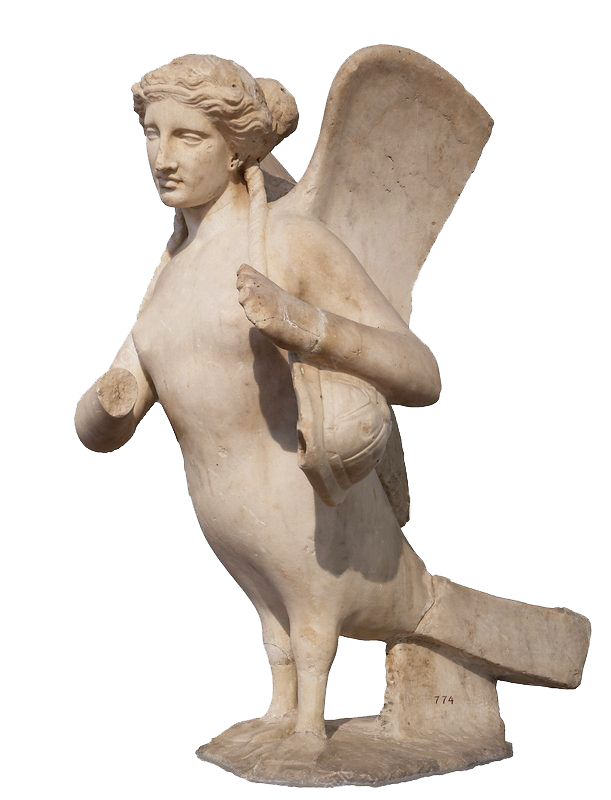
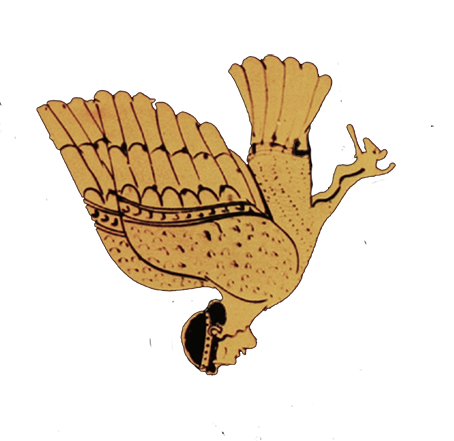
† In Greek mythology, the sirens (Ancient Greek: singular: Σειρήν, Seirḗn; plural: Σειρῆνες, Seirênes) were dangerous creatures, who lured nearby sailors with their enchanting music and singing voices to shipwreck on the rocky coast of their island. It is also said that they can even charm the winds.
The etymology of the name is contested. Robert S. P. Beekes has suggested a Pre-Greek origin. Others connect the name to σειρά (seirá, "rope, cord") and εἴρω (eírō, "to tie, join, fasten"), resulting in the meaning "binder, entangler", i.e. one who binds or entangles through magic song. This could be connected to the famous scene of Odysseus being bound to the mast of his ship, in order to resist their song.
The English word "siren", referring to a noise-making device, derives from the name.
* In folklore, a mermaid is an aquatic creature with the head and upper body of a female human and the tail of a fish. Mermaids appear in the folklore of many cultures worldwide, including Europe, Asia, and Africa.
Mermaids are sometimes associated with perilous events such as floods, storms, shipwrecks, and drownings. In other folk traditions (or sometimes within the same traditions), they can be benevolent or beneficent, bestowing boons or falling in love with humans.
The conception of mermaids in the West may have been influenced by the Sirens of Greek mythology, which were originally half-birdlike, but came to be pictured as half-fishlike in the Christian era.
The conception of the siren as both a mermaid-like creature and part bird-like persisted in Byzantine Greece for some time. The Physiologus ° began switching the illustration of the siren as that a mermaid, as in a version dated to the 9th century.
Wikipedia source: https://en.wikipedia.org/wiki/Mermaid
° The Physiologus (Greek: Φυσιολόγος) is a didactic Christian text written or compiled in Greek by an unknown author, in Alexandria; its composition has been traditionally dated to the 2nd century AD. The Physiologus consists of descriptions of animals, birds, and fantastic creatures, sometimes stones and plants, provided with moral content. Each animal is described, and an anecdote follows, from which the moral and symbolic qualities of the animal are derived.
Wikipedia source: https://en.wikipedia.org/wiki/Physiologus
Image of a mermaid from Francesco Redi, Opusculorum pars prior; sive, Experimenta circa generationem insectorum (Amsterdam, 1686), ii, plate between D2 and D3.
Image of a mermaid in Jean Jacques Manget, Bibliotheca Chemica Curiosa (Geneva, 1702), ii, fig 3. facing p. 216.
mermaid*
siren/mermaid
songs
notes/songs from the participants (abstracts - work in progress)
Life jacket
Man overboard
We fall again and again
Overboard
It takes us by surprise
We are in trouble again
Attacked by the sea of rigidity
losing control
Of our bodies and mind
Confused and miserable
Trying to keep our heads up
S.O.S. Emergency!
The sea of divide shall not respond
We expose danger
to ourselves and others
Please, throw to us
that life jacket of resilience (competence? shared reality? balance? thoughtfulness? tolerance? intelligence? creativity
LISTEN TO 'Mermaid Orgies' by the Amsterdam Queer Choir. CLICK ON THE IMAGE to access the link and SCROLL DOWN TO to the VIDEO.
inspiration
LISTEN TO 'Ocean Blue' - Keynote by Mayra A. Rodríguez Castro's at de Appel, 17.01.2022
CLICK ON THE IMAGE to access the link and SCROLL DOWN TO to the VIDEO.
Flags as an expansion of the existing ones + print outs (maybe in the form of cards) + workshop for making flags and messages
Suggestion to keep these interconnected and dense and not venture into more as they are already a lot.
Installation/display:
Work on a clear document on the specifications of display.
Work on alternatives for displaying the work in case initial plan is not possible at Stedelijk as alternatives.
Consider displaying the flags:
- at the front windows of the museum
- hanging from the stairs leading to the conference room
- hanging on the two polls at the back entrance of the museum
UNCUT PROPOSAL
(update 27.01.22)
The Beautiful Monster: Mermaids
CLICK ON THE IMAGE TO READ THE ARTICLE
siren/mermaid
songs
Siren sleeping song (a pretty mean siren song) version II
The ocean’s dream state
Let its gentle waves bring you there
Float to its magic
Let yourself drift away from responsibility
No-one can block you
Release
Letting go realities no longer serves you
Relax, re-charge
Let yourself go into the deep of the unknown
This ocean is your genuine ally
Sinking deep in the ocean of deep calm
Your body becomes a dream body
You become aware of my other dimension
You dive into my serene disappearance
You drift, you grow, we unite
fading flux vibrating an magnetic no-noise (or nothingness)
Here reveals your haven
Deep into my divine ocean of unconsciousness
swim
swim away from the coast
don't look back
feel your limbs detaching from the earth's dry, rock and dirt
until it aimlessly colours you blue
float
shamelessly
like the deep blue sea that you are part of
understand where you come from
absorb the sense of belonging
a blue, open, self-regulating system
continue swimming
ceaselessly
like the waves roll
with no care to offend any convention
no form, no right or wrong way to choose from
let their rhythmical shape take you away from the coast
no need to be afraid
have trust in the blue
listen
taste the saltiness behind the unorthodox
you want to be free.
let the water purify you
how will it provide you with its deliverance if you don't swim on it?
Marina
Maria
Sara
It’s the beginning of the earth, it’s the beginning of every life. How can a non-human entity give the birth to every human being? Everything is connected. We are made from water. We are water beings. We are octopus.
It doesn’t know the end. It doesn’t follow any goals. It transforms itself, changes its face, acts, protects, defends itself and goes on the attack. Immense, dark, infinitely in transformation. Listen to it, take care of it, pay attention.
Hope of salvation, identity’s changing. A different breath, apnea, a non-breath. Indistinct smells mingled with the avatar of the deep unconscious. We are here, we are slipping in the immense blue. Everywhere.Hey you! Has your heart been saved?
Probably any ritual now can save us.
The unconscious tells us to go, to cross the ocean for a better life. The primitive entity nourishes the hope of new identities by giving off smells of talc, acid gas and lavender. His is a performative language, it is only possible to live it, you cannot learn it. Sometimes it’s told, sometimes it is not allowed. It’s a risk to take, a dark area to face. The ocean, the brother of the catastrophe. A sound and gestural loop that allows us to hope for a decisive apocalypse. Our life is on the other side, we cross with courage, we breathe. Together.
I slowly approach my hand to the surface and I am quickly drawn down. My blue skin glides over the shiny scales. The long silky green hair moves fluidly following the rhythm of the breath. It’s rapid.
I was born here in this moment of transition. It has been a long journey on the surface but now the deep and the unknown are part of me. From here I feel the earth tremble and the wind sing. Someone says that becoming brave to save strangers' lives makes you the entity you’ve always wanted to be.
I remember giving molecules as food and pushing clouds of breaths upwards. Clay, orange and mint are mingled in a sharp and decisive sound until they dissolve into ice. We had been released.
Trapped in an irregular line I feel safe and travel far and wide. I feel protected, I watch the trees melt and the animals disappear. I look at the only mirror left: I see the immense darkness and listen to the sounds of nowhere. The fire blazes. My golden hands become four, then six, then eight. I start to run fast, the line is always next to me, so I change color. the heartbeat increases. Here you are.
It's morning. endless dark blue hope.
And no more lines.
UNCUT PROPOSAL
(update 03.2.22)
Reflections by Femke Herregraven
- The nautical flag system/language is a rather exclusive one.
It would be important to consider how we bring this to the public not in a mere didactical sense but through our poetic reconfiguration of it as we have already began to do.
For that, naming our flags and figuring out/naming what they signal is of great importance.
- Nation/state flags are symbols of power and sovereignty while nautical flags (and ours) function as temporal signals to the world. They go on and off in time and they replace each other.
Time might not be the right word but maybe rhythm is an interesting concept to think when displaying them.
- If we consider our flags as signals to the world maybe wise to consider displaying them outside - thinking of the Stedelijk as an island (bubble) and the public space/domain as the ocean.
- The creation of printed cards also sounded a good approach.
- Our work is a poetic acts so poetics will play an important role on how the work is communicated.
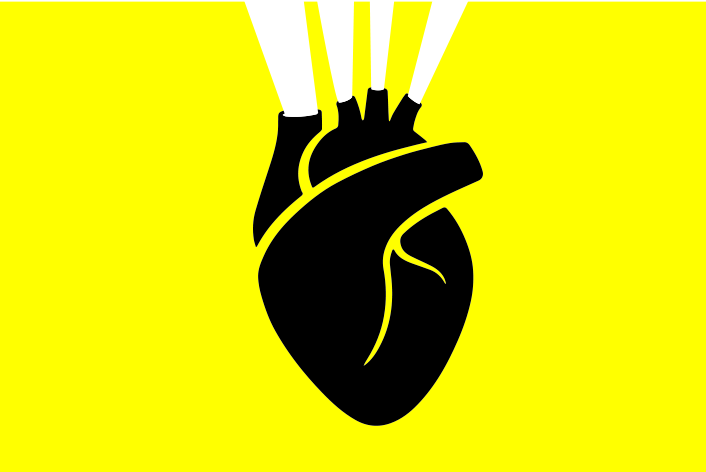
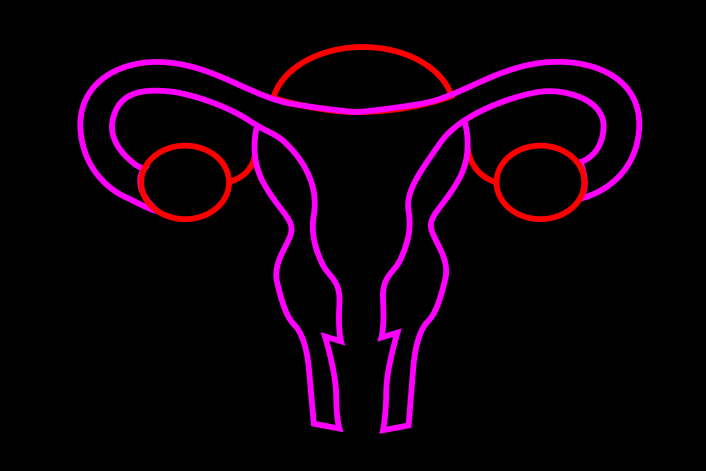
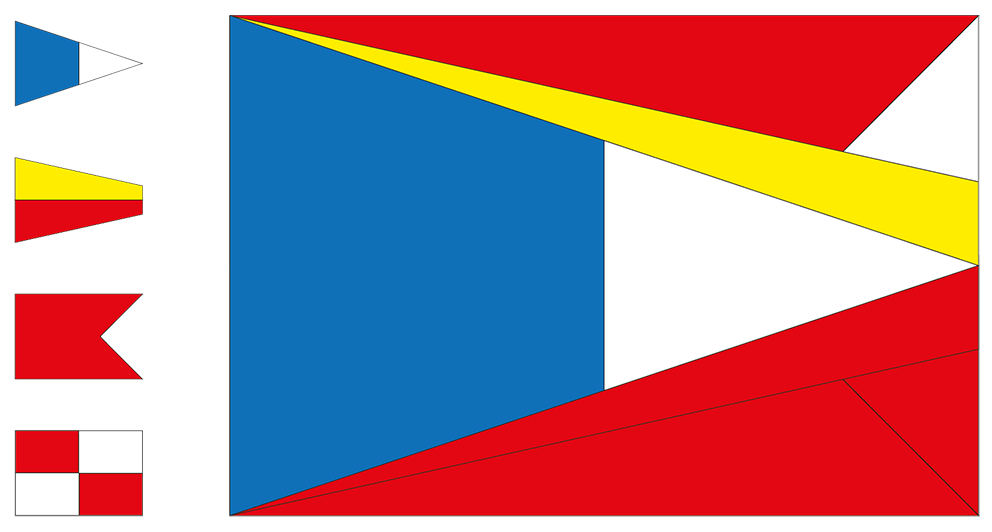
VOC monument - Ship on Helling by Marius van Beek, Wim Tap and Hank Beelenkamp, 1983
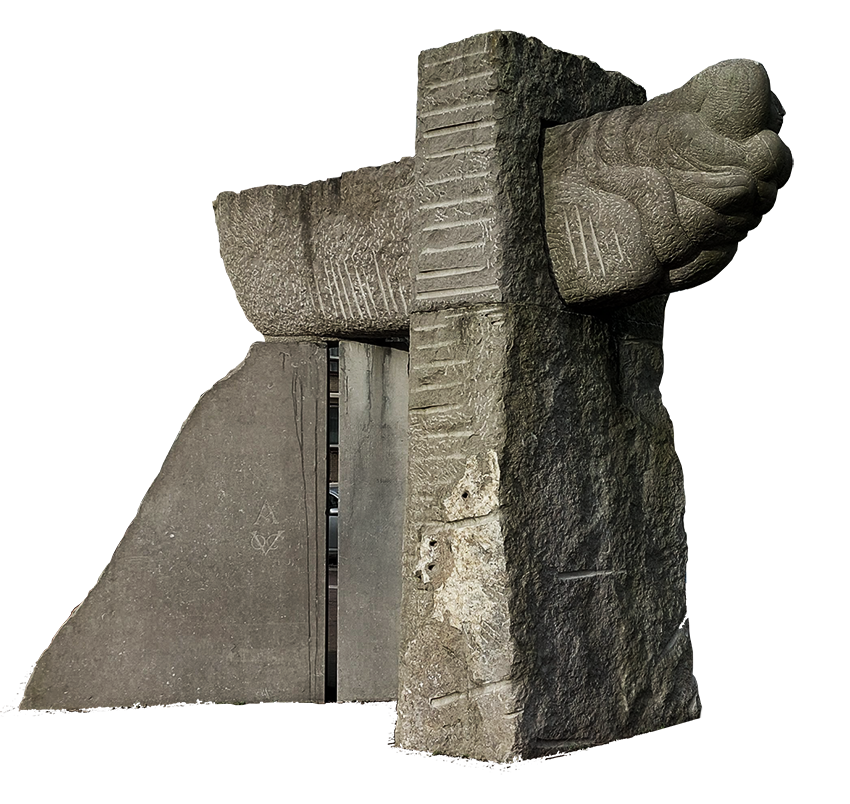
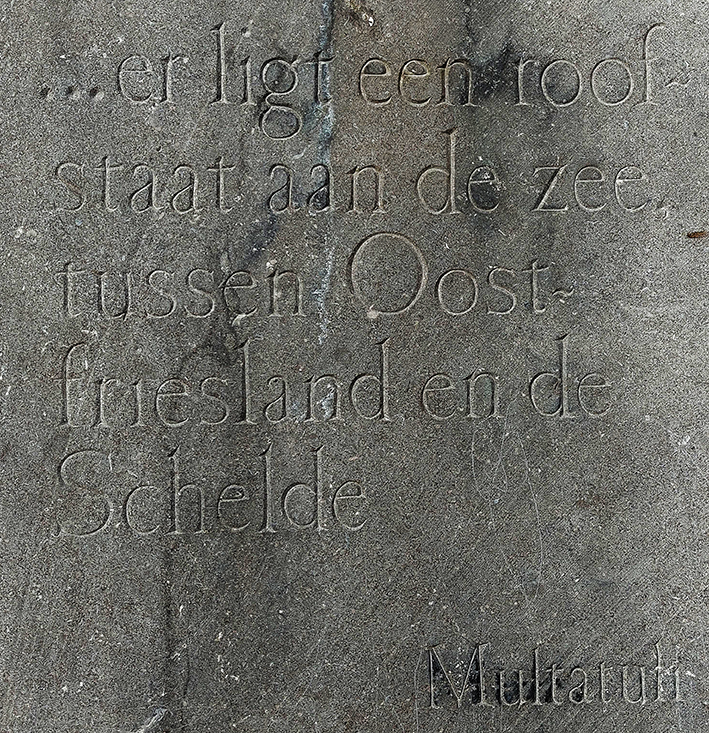
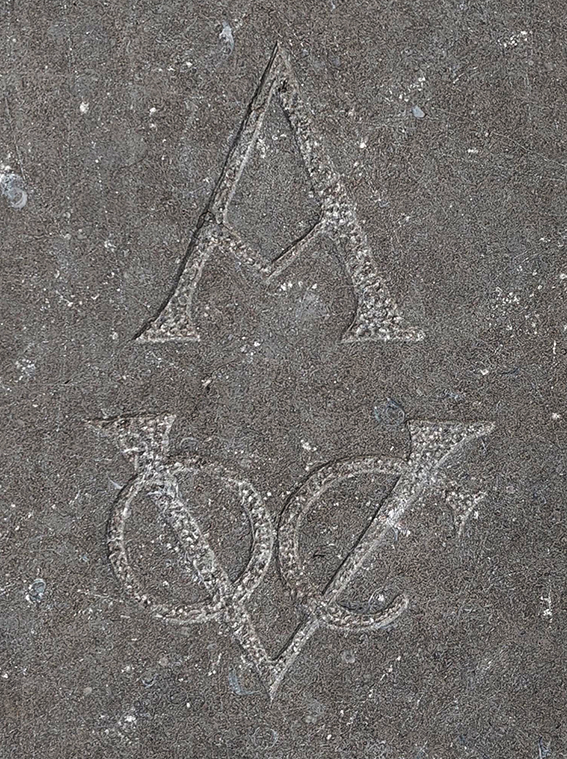
The statue is located at Wittenburg which used to be the dockyard of the ships of V.O.C. ( Dutch East India Company) in the 17th century. There is a symbol of VOC on the statue and also a quote of Multatuli from his book Max Havelaar.
The eastern islands of Kattenburg, Wittenburg and Oostenburg were created in the mid-seventeenth century. The expansion was part of a larger-scale expansion (Western Islands were also added) that went down in history as The Great City Explanation. The islands, which jutted out into the IJ, mainly served the Dutch East India Company.
The VOC had established its yards for the war and merchant fleet on Oostenburg from 1660. More than five hundred ships have been built at the shipyards in Oostenburg in just under a century and a half. Where the island ended in the IJ, the remains of two slipways, each twelve meters wide and fifty meters long, have been uncovered, dating from the seventeenth century. The find makes it clear that large-scale and industrial construction was already taking place at that time. In 1800 the heyday of the VOC and the shipping industry was over. The shipping industry was replaced by steel industry for the railways.
"Er ligt een Roofstaat tussen Oost-Friesland en de Westerschelde"
There is a robbery state on the sea, between East Friesland and the Westerschelde.
Quite of Multatuli from his book Max Havelaar. He declared that during the VOC the Netherlands had exploited its colonies, the Dutch East Indies, now is known as Indonesia.
Abstract from CHAPTER II: The Safe Zone by Nina Mingya Powles - Small bodies of water (Canongate Books Ltd. 2021)
View of the East Indies Sea Warehouse in Amsterdam (1726)
Print of the ruins of the former Oost-Indisch Zeemagazijn, seen from Wittenburg, April 14, 1822
The former East Indies warehouse of the VOC.
Now an apartment complex.
Map of the Eastern Isles in 1782; Oostenburg is on the left with the VOC warehouse across the island.
Oostenburg was taken into use by the VOC in 1665: shipyards and warehouses were set up there. The entire island was dominated by warehouses and wharves of the VOC, which functioned there for more than two centuries. In those years, this activity formed the center of the international trading metropolis of Amsterdam, with the large VOC warehouse, the East Indies Sea Warehouse from 1661-1663, built across the entire island of Oostenburg at the heart of everything.
About half of the VOC ships built between 1602 and 1799 (calculated in tonnage) were built in Amsterdam. The construction of a Spiegel Retourschip
took a year and a half; this was the most important type of transport ship of the VOC - a sailing ship for the transport of goods and people to and from Batavia , among others
After the dissolution of the VOC in 1799, the Oost-Indisch Zeemagazijn was put into use as a storage place for grains. Due to overdue maintenance and too heavy a load, the warehouse collapsed in 1822.
On April 13, 1822, the right wing collapsed spontaneously, and the rest of the wing collapsed the following night. The collapse of the right wing killed one person and injured four as grain carriers were working in the warehouse at the time. All the then stored grain (5 million kilos) was lost.
The theatrical demise of this great symbol of the VOC attracted many disaster tourists to the site. King William I also came to take a look. The ruins remained for years. It was not until 1829 that everything was cleaned up.
The northern part of the island was completely occupied by the new industrial activity. Werkspoor was the first modern industrial company to settle in Oostenburg.
In 1897 the now Werkspoor company received an order from the Nederlandsch-Zuid-Afrikaansche Spoorwegmaatschappij for 40 locomotives and 400 freight wagons. To this end, three large factory halls were built in Oostenburg in 1897 - lying next to each other, on the Oostenburgergracht.
session iv
walking route:
WITTENBURG - OOSTENBURG
09.02.2022